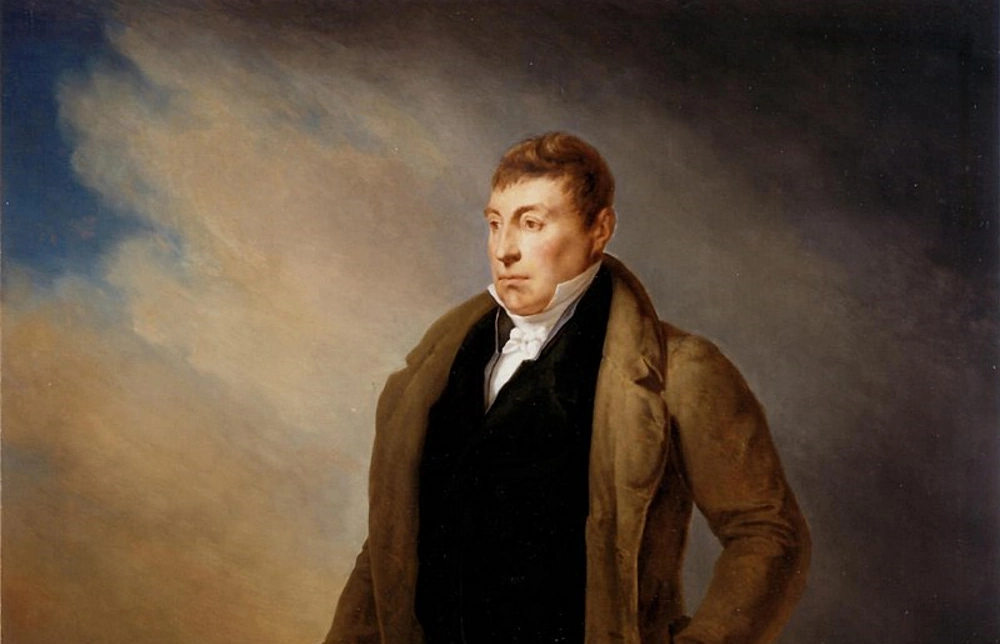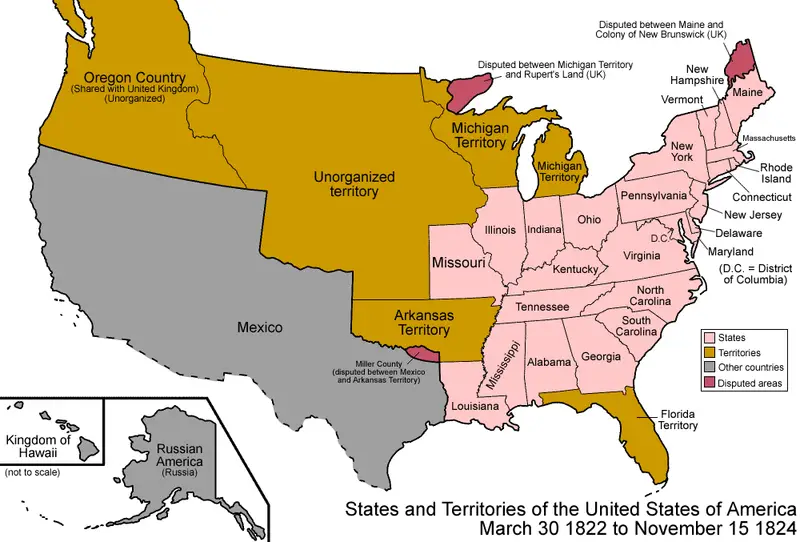When the Marquis de Lafayette returned to America for an extended tour of the 50-year-old Republic, he was no longer the slim young nobleman in a powdered wig.
At 66 years old, he had cropped his still-dark hair in the fashion of the day. He had acquired gravitas during his political career in France. Lafayette survived the tumultuous years of the revolution and its aftermath, which for him included a five-year prison term.
50 Years Flew By
In 1824, President James Monroe invited Lafayette, the last surviving general of the American Revolution, to tour all 24 U.S. states — 11 more than the original 13, including Maine and Vermont. Monroe wanted the visit to celebrate the nation’s 50th anniversary.

Portrait of Lafayette by Ary Scheffer. It hands in the U.S. House of Representatives.
Lafayette took him up on the offer, and what a celebration it was.
From July 1824 to September 1825, Lafayette traveled 6,000 miles to every state by stagecoach, horseback, canal barge and steamboat. He was greeted with rapture, escorted by cavalcades, feted and honored. People named streets, monuments and entire towns after him.
He left France on July 13, 1824 and was received a salute by artillery when he landed at Staten Island, N.Y., on August 15.
The First New England Visit
Lafayette visited New England twice, spending a month all told in the region. Heading north from Staten Island, he stopped briefly in New Haven, Conn., Providence, R.I., Stoughton, Mass., and Boston from August 21 to August 24. He had a splendid escort and enjoyed greetings of great demonstrations of joy — so great, he had to travel at night to make progress.
He arrived in Cambridge, Mass., on August 25, and settled into the Boston area until August 31. During that time he visited former President John Adams in Quincy, Mass.
The next day he stopped in five Massachusetts cities and towns: Lexington, Concord, Salem, Marblehead, and Newburyport. He visited the Old North Church and, noticing a bust of George Washington, said, “Yes, that is the man I knew and more like him than any other portrait.”
On September 1, he visited Portsmouth, N.H., then headed south again to Boston and Lexington.
Worcester, Mass., and Tolland, Conn., were on his agenda on Sept. 3. Then on Sept. 4, Hartford and Middletown, Conn.
Second New England Visit
Lafayette then visited familiar places: Philadelphia, Delaware, Virginia. He spent some time in the new capital, Washington, D.C., then south to Maryland, the Carolinas and Georgia. He turned west to see the new states of Alabama, Mississippi and Louisiana, then up the Mississippi River in a steamboat to Missouri, Tennessee, Kentucky, Illinois, Indiana and Ohio. Then he traveled back through Pennsylvania to New York, where he saw Niagara Falls and went to Albany by way of the Erie Canal. From Albany he traveled straight to Boston.
On June 17, 1825, Lafayette began his second New England tour by laying the cornerstone of the Bunker Hill Monument – exactly 50 years after the battle was fought. He was surrounded by “such a civic and military display as is seldom seen among men.”
Daniel Webster gave a rousing speech for the occasion. A grand two-mile long procession marched from the Boston Common, with the 40 survivors of the battle following in eight carriages.
Lafayette then laid the cornerstone at the monument with the help of some masons. The platform held a thousand ladies. Then 4,000 people sang odes, gave toasts and ate an enormous dinner.
Northern New England
A less grand reception, but no less sincere, met Lafayette in northern New England. He spent the night of June 23 in Dover, N.H. That night, a delegation of citizens from South Berwick, Maine, invited him to breakfast. He accepted. The next day he was greeted with an arch of evergreens, festooned with oak leaves and roses. A cavalcade escorted him to the Cleaves Hotel in Saco, then he visited Biddeford and Portland. During the few hours he spent in Portland, 15,000 Mainers saw him.
On June 27, he arrived late at night in Claremont, N.H. Early the next day, he crossed over the Cornish Bridge to Vermont, passing through Woodstock late in the morning, then took a stagecoach over the mountains to Barnard and Royalton. In Randolph; Vt., he was said to have met a young Justin Morrill and eventual Senator Dudley Chase.
Gov. Cornelius P. Van Ness escorted him through Barre. Large festivities greeted him in Montpelier, where he spent the night at the historic The Pavilion.
On Wednesday, June 29, 1825, Lafayette met with women’s groups in Montpelier and then left for Burlington, his last stop in New England.
Departure of Lafayette
On Sept. 6, 1825, President John Quincy Adams bid him farewell. A new ship outfitted for him was named after a battle — the Brandywine. Though wounded at Brandywine, Lafayette had ordered a successful retreat.
He left behind dozens of places named after him, including Lafayette Village in North Kingstown, R.I., Mount Lafayette (and Lafayette Campground) in Franconia, N.H., and Lafayette Park in Manchester, N.H.
Lafayette died on May 20,1834. He lies buried in Picpus Cemetery in Paris, under soil from Bunker Hill.
With thanks to Recollections of General Lafayette on His Visit to the United States, in 1824 and 1825; With the Most Remarkable Incidents of His Life, from His Birth by Amos Andrew Parker. This story was updated in 2022.


20 comments
Pass his statute every day on the University of Vermont campus.
Nice portrait!
[…] Island, which is named for him. In the 1780s, with mounting debts, he turned to his old friend the Marquis de Lafayette to arrange a profitable post supplying goods, including timber, to the French […]
[…] planter, and the family lived in a large stone house in Newport near Narragansett Bay. The Marquis de Lafayette and Count Rochambeau visited the opulent residence during the Revolutionary […]
Lafayette’s visit to Ipswich is at https://ipswich.wordpress.com/2014/02/06/when-lafayette-came-to-ipswich/
[…] Early in 1776, the Congress sent him, alone, to France to persuade the French government to send soldiers, guns and money in support of the American Revolution. Deane managed to get informal support from France, including ships, arms, surplus military supplies and officers like the Marquis de Lafayette. […]
[…] Revolutionary War veterans dinner was inspired by the visit of the Marquis de Lafayette to the United States to commemorate the country’s 50th anniversary. He hosted it at the large […]
[…] winter headquarters during the Siege of Boston. She had stayed close to Mount Vernon, but as the Marquis de Lafayette said, she loved her husband […]
[…] Lebanon Green. Visitors who came to see him included George Washington, Henry Knox, Israel Putnam, Marquis de Lafayette and Count Rochambeau. Both the house and the War Office are still on the mile-long […]
[…] Marquis de Lafayette seldom forgot a friend, as he showed when he visited Vermont in 1825 on his final celebratory tour of America. Learning of Barton’s predicament, the French […]
[…] moved to New Orleans and became a great philanthropist, donating the last $10,000 to build the Bunker Hill Monument. Abraham donated funds to maintain the Touro […]
[…] lived in a large stone house in Newport near Narragansett Bay. During the American Revolution, the Marquis de Lafayette and Comte de Rochambeau visited the Robinson […]
[…] said Cox. Those false pies were called Washington Pies, light cakes with a cream or fruit filling. Lafayette Pies were […]
[…] Tyler and persuaded him to visit that city, as well. He traveled there after the dedication of the Bunker Hill Monument. There he learned of a new disaster brewing for his administration – his attorney general had […]
[…] Revolution (before the British trashed his farm) he hosted a dinner for George Washington and the Marquis de Lafayette. He offered them two bottles of the best French wine and 12 bottles of Greening cider. Each guest […]
[…] Tyler and persuaded him to visit that city, as well. He traveled there after the dedication of the Bunker Hill Monument. There he learned of a new disaster brewing for his administration – his attorney general had […]
[…] question, “Where was the shot heard round the world fired?” surfaced in 1824. Then the Marquis de Lafayette visited all 24 states to celebrate the 50th anniversary of independence. When he arrived in Lexington, Mass., people told […]
[…] in France, they renewed their old friendship and indeed became very close. In 1824, now-President Monroe invited Lafayette to visit the United States, soon to celebrate its 50th anniversary as a […]
[…] Lafayette, by the way, when he was invited back to the United States by President James Monroe to tour the country in celebration of the 50th anniversary of the revolution, as the only living general of that war, […]
[…] would welcome the Marquis de Lafayette when his tour of America came to Troy, and would visit him in France when she traveled there, hearing his firsthand account […]
Comments are closed.